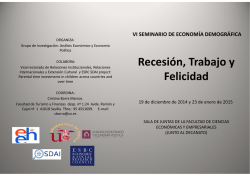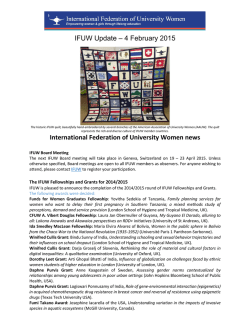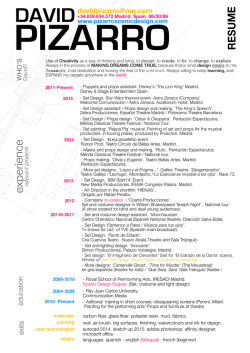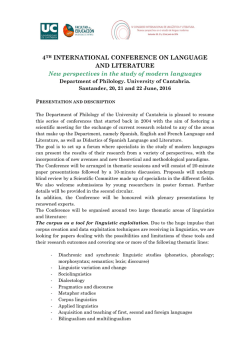
Cartaphilus
CALL FOR PAPERS Cartaphilus. Revista de investigación y crítica estética Special issue: «Theatre landscapes: violence in the theatre» Universidad de Murcia Volume 14, 2016 Gertrude: Her clothes spread wide; and, mermaid-like, awhile they bore her up: which time she chanted snatches of old tunes; as one incapable of her own distress, or like a creature native and indued unto that element: but long it could not be till that her garments, heavy with their drink, pull’d the poor wretch from her melodious lay to muddy death. [William Shakespeare, Hamlet, Act IV scene VII] (The Father pulls his hair, stretches his head up and places the noose around his neck. The father climbs down the ladder). FATHER AND MOTHER.- ¡One, two… three! (The Mother removes the chair swiftly as the Father simultaneously pushes him violently. PIBE’s body sways around the room. Moans and convulsions are heard. His body crashes the mirror mid- swing, which takes the form of a cobweb). [Eduardo Pavlovsky, Telarañas] Over a mountain of dismembered dolls. Narrator.- When Elsa and Mateo Palavrakis said goodbye to the rest of players, they did not know that they would be dead that very night. Mr. and Mrs. Palavrakis tumble down the mountain of dismembered dolls carrying lit candles in their mouths. [Angélica Liddell, El matrimonio Palavrakis] Since its origins, theatre has frequently resorted to the staging of violence. As the fragments above illustrate, violence has adopted a variety of forms in the theatre; ranging from the narration of violent acts that are taking place offstage, as in the case of Ophelia’s drowning, to the act actually being performed in front of the spectators. In both cases the audience is cognisant of the fact that violence in not real. Ophelia’s death, the hanging described by Pavlosky and the corpses tumbling down the mountain in Liddell’s work, are all fictional. However, the effect that they purpose to have on the spectator is independent of their real or fictitious nature. The violence that they represent is aimed at making an impact on the audience. The relationship between theatre and violence gives rise to questions regarding both how violence is brought into the stage, as well as how the spectator reacts to this violence. According to Jean Graham-Jones (1996), the reception of Eduardo Pavlovsky’s Telarañas at its premiere was heavily influenced by the wave of violence in the country (Argentina, 1977), and by the beginning of the dictatorship known as Proceso de Reorganización Nacional (1976-1983). At that moment, the violence onstage could be interpreted as a reflection on the violence in the country. The same play would prompt different reactions when staged years later, or simply when performed outside Argentina. The violence depicted remains the same, but its meaning is altered and subjected to different readings. With or without a historical reference, the relationship between theatre and violence is complex, and the effect of the violence onstage can even be more powerful than that of real violence. In the words of Lucy Nevitt, the relationship between violence in the real world and violence in the theatre is such that, “Paradoxically its impact can be less immediate and strong, and less long-lasting and troubling, than the impact of some simulated violence presented in theatres” (Nevitt, 2013: 3). Apart from its relationship with reality and the effect over the spectator, the study of theatre and violence can also address the nature of violence itself (physical or psychological), the forms that it adapts (murder, suicide, blackmail...) or how violence is represented in different genres. Violence and theatre have been tightly connected throughout history albeit adopting different forms depending on time and place. In Ancient Greece, murder and death take place offstage whereas Roman tragedies integrate violence as a key element of the spectacle. These Roman tragedies, in particular those by Seneca, influenced centuries later the genre of revenge tragedy in the English Renaissance, a genre initiated with Thomas Kyd’s The Spanish Tragedy. Meanwhile, violence in other European theatres takes more diverse forms: from the fencing battles in Spanish Golden Age theatre to the tragedies by Racine and Corneille. Nineteenth-century theatre introduces a kind of violence that is legitimised by justice, as Tom Sellar has noted (Sellar, 2005: 11). The exploration of theatre and violence has gained even more importance in the twentieth and twenty-first centuries. The violent events of this time have led to new forms of violence in the theatre, ranging from the emergence of the Theatre of the Absurd after the Second World War, to more contemporary reflections after the 9/11 attacks in New York. Twentieth-century trends placing violence at the core of the theatrical event have also emerged. Such is the case of the in-yer-face theatre, teatro de la memoria (‘theatre of memory,’ Floeck, 2005), or teatro de los muertos (‘theatre of the death,’ Dubatti, 2014). Beyond theatre, artists as Marina Abramović or Chris Burdeno have also addressed the relationship between violence and performance. Under the light of so many expressions of theatre and violence, it is natural that Antonin Artaud has been one of the most influential theorists of modern times, with his book Theatre of Cruelty considering violence and cruelty in relation to theatre creation. The representation of violence in theatre leaves the door open, as Nevitt has commented, to think about the very nature of violence (Nevitt, 2013:6), as well as to revisit its historical evolution and its manifestation in contemporary theatre. This special issue of Cartaphilus welcomes proposals that continue with this reflection. The proposals might want to address one or several of the following suggested questions: How has the performance of violence evolved throughout theatre history? How is violence represented in contemporary theatre? What are the aesthetics of violence in theatre? What are the effects of violence on the spectator? Why is violence brought to the stage? How has violence appeared in different dramatic genres? What is the relationship between the theatrical event (from the dramatic text to performance) and violence? Alba Saura Clares and Isabel Guerrero Editors of the special issue SELECTED BIBLIOGRAPHY AA. VV. (2002): “Teatro de la Violencia”, Primer Acto, 293 (2), 5-66. Artaud, A. (1986): El teatro y su doble. Barcelona: Editorial Edhasa. Balfour, M., Thompson, J. y Hughes, J. (2009): Performance in Place of War. Greenford: Seagull. Dollimore, J. (2010): Radical Tragedy: Religion, Ideology and Power in the Drama of Shakespeare and His Contemporaries. Basingstoke: Palgrave Macmillan. Dubatti, J. (2014): Filosofía del teatro III. El teatro de los muertos. Buenos Aires: Atuel. Escudero, J. M. y Roncero López, V. (2010): La violencia en el mundo hispánico en el Siglo de Oro. Madrid: Visor Libros. Graham-Jones, J. (1996): “Framing the Proceso: Two Productions of Telarañas by Eduardo Pavlovsky”, Latin American Theatre Review, 29 (2), 61-70. Hughes, J. (2011): Performance in a Time of Terror: Critical Mimesis and the Age of Uncertainty. Manchester: Manchester University Press. Floeck, W. (2006):“Del drama histórico al teatro de la memoria. Lucha contra el olvido y búsqueda de identidad en el teatro español reciente”. In J. C. Romera Castillo (Ed.), Tendencias escénicas al inicio del siglo XXI (pp. 185-210). Madrid: Visor Libros. Nevitt, L. (2013): Theater and Violence. New York: Palgrave Macmillan. Mizra, R. (2008): Teatro y violencia en la escena contemporánea. Uruguay: Ministerio de Educación y Cultura, MEC. Sellar, T. (2005) (coord.): “Theater and Violence”, Theater, 35 (1), Duke University Press. Sierz, A. (2005): In Yer Face Theatre: Interpreting New Writing for British Theatre in the 1990s and After. University of Westminster. GUIDELINES FOR SUBMISSION This special issue of Cartaphilus welcomes contributions on any aspect of the topic of theatre and violence. Submissions should be sent online via OJS, (http://revistas.um.es/cartaphilus.php) before 1st October 2016. Authors should register in the platform and send their contributions in Word format (.doc or .docx). Contributions can be in English or Spanish. The document for submission should include the title of the article, the complete name of the author or authors, institutional affiliation and e-mail address. Contributions should be accompanied by a 250-word summary and 5 key words in English and Spanish. The editors can provide the summary and keywords in Spanish for English contributions if required. Both the abstract and the keywords should convey the essential aspects of the contribution. FORMAT Font Times New Roman 12, line spacing 1,5. Footnotes numbered and in Times New Roman 10. In-text quotations will be referenced indicating author, year (Castany, 2013). Authors with several works published in the same year will be indicated as follows: Castany, 2013 and, later, Castany, 2013b ... The reference list should follow APA style. Please do not submit contributions under consideration by another editor or published elsewhere (either in print or internet). Only original research pieces are published by Carthapilus. DEADLINES Submission of originals: 1 October 2016 Acceptance of originals: 1 November 2016 Expected Publication Date: December 2016 Contact Alba Saura Clares [email protected] Isabel Guerrero [email protected] Equipo editorial de Cartaphilus ISSN: 1887-5238 Depósito Legal: MU-1973-2010 Directores Vicente Cervera Salinas, Universidad de Murcia María Dolores Adsuar Fernández, Universidad de Murcia Mercedes Serna Arnaiz, Universidad de Barcelona Bernat Castany Prado, Universidad de Barcelona Comité científico Consejo de redacción Alfredo Rodríguez López-Váquez, Universidade da Coruña Adriana Astutti, Universidad de Rosario Daniel Mesa Gancedo, Universidad de Zaragoza David Viñas Piquer, Universidad de Barcelona Fernando Moreno, Universidad de Poitiers Francisco Jarauta Marion, Universidad de Murcia Jorge Chen Sham, Universidad de Costa Rica José R. Jouve Martín, McGill University José María Pozuelo Yvancos, Universidad de Murcia Liliana Tabakova, Sofía University “St. Kliment Ohridsky” Pedro Pérez Leal, Universidad de Geoergetown Silvia Ruiz Otero, Universidad Iberoamericana de México Verónica Salles-Reese, Universidad de Georgetown María Belén Hernández González, Universidad de Murcia Cecilia Enjuto Rangel, Universidad de Oregon Francisco Javier Sánchez Martín, Universidad de Murcia Isabel García Adánez, Universidad Complutense de Madrid Marta Sánchez Orense, Universidad de Murcia Chiara Bolognese, Università di Roma “La Spienza” Pedro Antonio Férez Mora, Universidad de Murcia Pedro García-Caro, Universidad de Oregon Raquel Velázquez Velázquez, Universidad de Barcelona Rosario Guarino Ortega, Universidad de Murcia
© Copyright 2025





